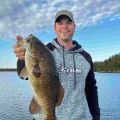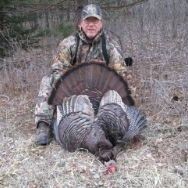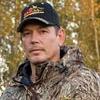OutdoorMN News - DNR crews see productive winter of prairie habitat restoration
-
Your Responses - Share & Have Fun :)
-

By carlsonmn · Posted
That was a better study compared to last winter when they setup the vertical tube nets and tried to release exhausted fish from being studied and expected them to be able to swim straight down a 3' hoop net. That lake's crappie population from this latest video was pretty deep at 40-50', and no doubt from those depths that is barotrauma for most. That is deeper than most crappie holes but certainly how some are. However from helping give fish a good release from the 35' and less range and tracking them with live sonar most of them swim at a shallow angle back to the depths and I watch them rejoin the school and be active. Uncut Angling's video helped counter some of the initial narrow findings. -

By SkunkedAgain · Posted
If you fished with me more often, you'd never have to make this statement... 38" of ice - love it. I'm really going to have to dig around for my auger extension. I don't think that I've needed it in over a decade. Too bad nobody has a locomotive chugging across the ice to do some logging, like the good old days. -
.thumb.jpg.5c1a86e9339e49e53f5bfefed2220054.jpg)
By LakeofthewoodsMN · Posted
On the South Shore... Ice fishing remains strong across the south shore of Lake of the Woods out on Big Traverse Bay. Resorts and outfitters on some parts of the lake have ice roads extending over 16 miles staying on nice schools of walleyes and saugers. Many fish houses are over deep mud. Some are on structure. It is always fishing of course, but overall, February has been very productive for most anglers. Extensions are being used on ice augers as the ice continues to thicken. The thick ice this year will be good for the extended ice fishing season Lake of the Woods enjoys with fish houses out through March 31st, walleyes and saugers open through April 14th and a pike season that never closes. Most fishing activity is taking place in 26-32 feet of water. Anglers are finding a healthy mix of walleyes and saugers, with a good number of jumbo perch in the mix this year. Some big eelpout are also showing up. Anglers are reporting plenty of fish for fresh fish frys and usually extra fish to bring home. The one-two punch of a jigging line and deadstick is the way to go. On the jigging line, jigging spoons with rattles tipped with a minnow head have been consistent. Lipless crankbaits and jigging rap style lures also doing well. Lures with a light have been working well in the stained water. Please remember, in MN, lures with a light or water activated light can be used as long as the battery is mercury free and the hook is attached directly to the lure and not as a dropper line. On the deadstick, a plain hook or a small jig with a live minnow 6 inches to a foot off of the bottom. Some days, mornings are better, other days, it's the afternoons. There is no distinct pattern, they could come through at any time. On the Rainy River... The start of the day and end of the day have been best for those targeting walleyes on the river. A jig and minnow or a jigging spoon tipped with a minnow head is also producing some fish. Some big sturgeon being iced by ice anglers targeting them. It is a catch-and-release sturgeon season currently. Although ice conditions on the river are good, they can vary significantly due to the current, so anglers should always consult local resorts or outfitters for the most up-to-date safety information and fishing advice. Up at the NW Angle... Ice fishing has been strong in the islands area of Lake of the Woods. Resorts continue to move their fish houses around, staying on the best schools of walleyes. Anglers are catching a nice mix of walleyes, saugers, and jumbo perch with an occasional pike or tullibee as well. Big crappies are still being caught just over the border. Fish houses are available, check with a NW Angle resort for info on crappie fishing. Lake of the Woods enjoys an extended ice fishing season with fish houses on the ice through March 31st and walleye and sauger seasons open through April 14th. Perch, crappie, and pike seasons remain open year-round. -

By leech~~ · Posted
Maybe you should put rattle wheels down, if your going to sleep for 6hrs! 🤭 😆 -
By JerkinLips · Posted
Monday was my worst day of winter fishing on Vermilion in the last 4 years. Caught only one 14" walleye in nearly 8 hours of fishing. Missed two other bites and was marking very few fish. Maybe the fish were taking Monday off after a big weekend. No more water came up on the ice under my house. Think it was because I haven't banked snow around it for a couple of weeks so the bare ice around the house is getting very thick. I measured 38" of ice under my house and the Ion barely made it through even with the extension installed. Needless to say I banked around the house this time. Another lesson I learned today is don't drill holes if ice is frozen on your blades. I did that on one hole and it didn't center properly and drilled at an angle on the edge of the opening. Hope I can correct the location and angle on my next trip up. Not much change in the surface lake surface conditions. The drifts may be a little higher and are definitely harder. There are still a few bare ice spots on the lake. Very little activity on the lake today. There are about 3 dozen houses from McKinley Park out to Birch Island. Another person pulled there house off today, and I am sure many more will pull theirs off this coming weekend. Only 13 days left of walleye season. -

-

By leech~~ · Posted
Um, #metoo leech~~ Author 'we have more fun' FishingMN Builders Posted January 26 My whole goal for the rest of this season. Is to watch KC lose and Taylor cry! 🥳 -

-

-

By Dash 1 · Posted
Great looking food. So far not much of a game and I thought the halftime show was worse I've seen.
-


Recommended Posts
Join the conversation
You can post now and register later. If you have an account, sign in now to post with your account.
Note: Your post will require moderator approval before it will be visible.